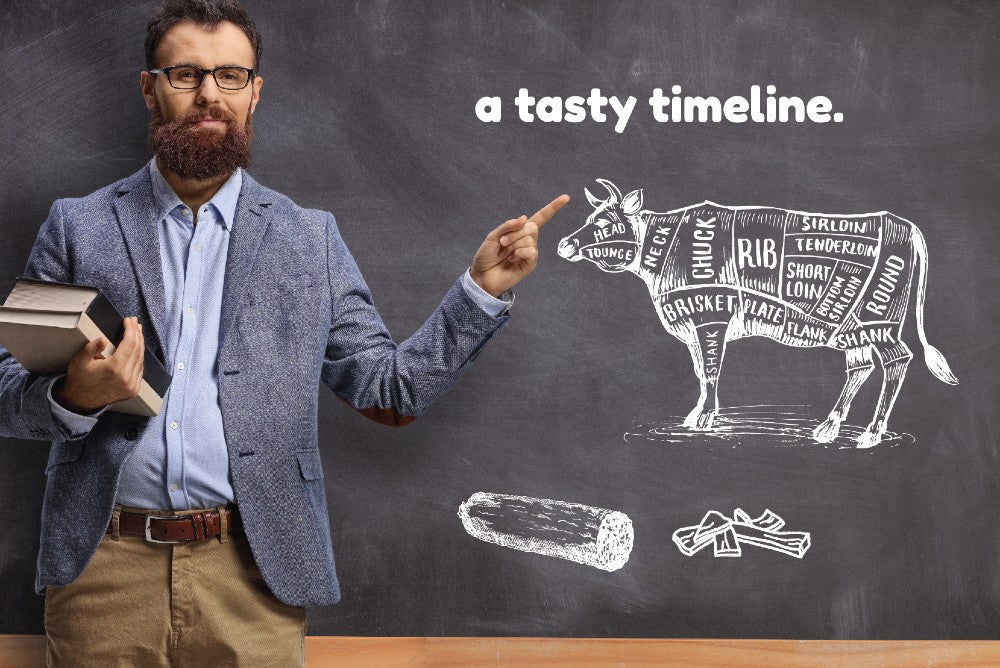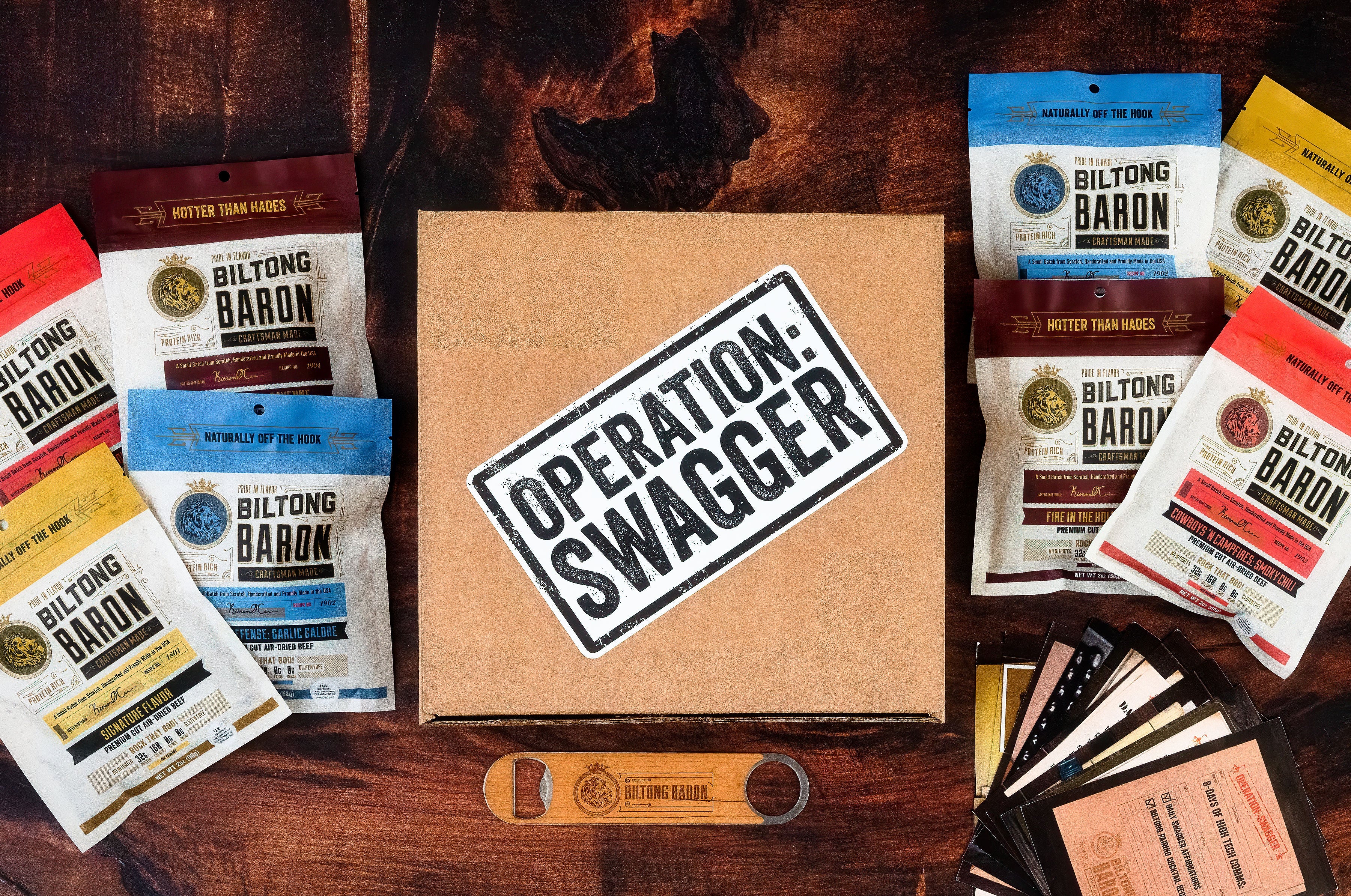-
Recently Viewed
You have no recently viewed items.
-
Featured Brands
- All Products
- About Us
- Contact Us
- Our Blog

Where Does Beef Jerky Come From? Beef Jerky History
When you think of the old days of meat preservation, you may imagine Laura Ingalls Wilder’s dad smoking meat in their hollowed-out tree.
While early Americans certainly had to find ways to preserve their foods to provide sustenance for their families, the practice started much earlier. The history of beef jerky is fascinating, and pinpointing where beef jerky originally comes from isn’t a simple answer.
If you’re wondering when beef jerky was invented, it may surprise you to learn the version we know and love can be traced to the Inca Empire. However, even the ancient Egyptians were drying out meat!
Who Invented Beef Jerky? And When Was Beef Jerky Invented?
The process of cooking meat to make it last without the disposable power access we have today lends its name to the delicious snack. Evidence of preserved meat has been seen in ancient civilizations around the world. However, the closest version to the beef jerky we know today has the Inca Empire (1438-1533) to thank.
The History of Beef Jerky
Ancient Egyptians
The ancient Egyptians really did have it all figured out. From cosmetics to planned societies, it’s no wonder they know a thing or two about extending the life of their food supplies.
This early civilization would leave portions of both meats and produce to dry in the sun. While it’s not the same process used today, the basics were there.
Drying meat was such an important part of their society that excavated tombs have been found with abundances of preserved foods. Some of which were in pretty good shape, but we wouldn’t dare you to sample food that’s hundreds of years old!
Ancient Rome
The ancient Romans had their own Italian twist on preserved meat, and we wouldn’t expect anything less!
While it was consumed mostly by poor farmers, it was seasoned and prepared into a delicious and popular meal. Coppiette, meaning “little couples,” was traditionally made from tying meats — typically from horses, donkeys, sheeps, and goats — in twos. First, the meat was seasoned with red pepper, fennel, and salt. Then it would be tied and left to dry in front of a hearth for two months.
Coppiette can still be found in Rome today, although it’s now typically made of pork.
West Africa
Ethiopians and Nigerians alike both have a long history of preparing their own form of jerky.
Quant’a, as Ethiopians call it, consists of strips of meat seasoned and dried. Still popular in both Ethiopia and Eritrea today, this meal is typically seasoned with salt, pepper, and berbere, which is a spice mix of chili peppers, ginger, basil, fenugreek, and garlic.
If you venture to the Nigerian region, you can still enjoy their ancient style of jerky called kilishi. Considered a delicacy, kilishi is made from cows, sheep, or goats. The muscle meat is cut off in sheets and then dried in the sun. After drying out, the sheets of meat are then marinated in a sauce of water, peanut, ground onions, and spices. Then it is once again dried before being roasted.
Quechua Tribe of South America
The Andes Mountains in modern-day Peru boast a unique climate perfect for drying meat. And in a world remembered best by historians, these early populations had to find ways to preserve their meats and other foods to last as long as possible.
Without freezers, backyard smokers, and BBQ pits, preserving food was crucial. Especially if you consider the large animals the farmers would provide their communities, they put a lot of effort into using every piece of the animal. From the hides to the bones, we could learn a lot about resourcefulness and reducing food waste from the Inca Empire.
Another fun fact, the word jerky derives from the Quechua word ch’arki, which means “to burn meat.” And the Quechuan people did just that by drying meat in the hot sun and then leaving it out to freeze on the cold nights. Once the Spanish conquistadors arrived, they adapted the word to charqui, which translates to jerky.
The alternating hot days and cold nights had huge advantages for preserving large scales of meat. Each year, 15% of the herds were slaughtered for food. While they enjoyed the freshly cooked meat, these early people also turned much of it into ch’arki to ensure sufficient food supplies throughout the year.
Early Native Americans
Heard of pemmican?
This was the early Native American tribes’ version of preserving meat. Pemmican is similar to the beef jerky we know today, but with a twist.
Long before settlers began colonizing the United States, the native people of our country made nutritious small protein-packed cakes. These foods had combinations of mixed berries, fat, and ground meat. Combining the process and ingredients allowed for a long shelf life for these go-to nutrient-dense snacks.
Native Americans didn’t only rely on pemmican, though. In fact, the various tribes each had their own versions of smoking meat. The techniques ranged from using large open fires to small enclosures. Some of the most traditional smoking techniques used tipis and smoke sheds that were large enough for the large quantity of game.
As people who lived off the land, their hunters often targeted large animals. In particular, bison and other wild game were popular meats throughout most tribes. Not only did these enormous animals provide food, but their lean meat made smoking it down into jerky relatively simple. Northern tribes heavily relied on smoking fish to last throughout the bitter cold winter months.
As explorers ventured into the new world and learned from the natives, jerky would continue to grow in popularity. You can thank John Smith for naming jerky in his 1612 map of Virginia, where he wrote, “as drie as their jerkin beefe in the West Indies.”
American Cowboys
While what we know today as beef jerky was around far before American cowboys, they certainly put their own spin on the snack.
As early as the 1820s, cowboys carried dried and salted meats during their days of herding cattle. Typically, cowboys would prepare the meat by drying it in the sun, smoking it, and then salting it. The meats would include cattle, bison, elk, antelope, deer, and other wild game.
This style of jerky is now considered the old-fashioned “cowboy-style jerky.” It can be characterized as tougher, drier, chewier, and, of course, delicious.
The Beef Jerky Renaissance
It’s fair to say that pinpointing who first invented beef jerky is close to impossible. The practice of preserving meat through various drying, smoking, and roasting methods has been done throughout centuries across the world.
These days, as people aim to eat more consciously, beef jerky is seeing a renaissance. The handy high-protein snack that’s quick to grab is great for anyone looking to lose weight, keep their energy up, or simply always have a scrumptious bite on hand.
Keep Exploring the Jerky Universe
Have more jerky questions? We have more answers.
Follow us on social and subscribe to our newsletter below to continue exploring the Jerky Universe!
- Choosing a selection results in a full page refresh.









